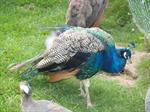The Certificate in Wild Animal Studies focuses on wild animals.
 It is a useful qualification for people who work in zoos or with animals and want to learn more about them.
It is a useful qualification for people who work in zoos or with animals and want to learn more about them.
The certificate consists of 6 core modules, each of which should take students around 100 hours to complete.
You can start the course at any time. It is studied by distance learning, so you can study in the comfort of your own home. This doesn't mean you are all alone in your studies; our highly qualified and friendly tutors are there to help you every step of the way. If you have any questions at all, they are always happy to help.
 Each module contains a number of lessons. There is an assignment at the end of each lesson and this should be submitted to your tutor for marking. Your tutor will then provide feedback on your work and, if appropriate, suggest further reading.
Each module contains a number of lessons. There is an assignment at the end of each lesson and this should be submitted to your tutor for marking. Your tutor will then provide feedback on your work and, if appropriate, suggest further reading.
At the end of each module, there is also an examination which you can take at a time and location to suit you.
To pass the course you are required to pass all assignments and 6 exams.
 If you are not sure about going straight to the certificate, you can study each of the modules mentioned as a standalone course. Please click on the links for more information.
If you are not sure about going straight to the certificate, you can study each of the modules mentioned as a standalone course. Please click on the links for more information.
Modules
Note that each module in the Qualification - Certificate in Wild Animal Studies VEN026 is a short course in its own right, and may be studied separately.
What are Animal Rights?
 Animal rights follows the philosophy that it is morally wrong for humans to utilise animals in any way. The key principle is that non-human animals (like humans) exist for their own sake. In other words, animals should not be used for human purposes. Animal rights view the use of animals by humans as an action that trivialises their lives, where their lives are valued according to human standards of utility and money.
Animal rights follows the philosophy that it is morally wrong for humans to utilise animals in any way. The key principle is that non-human animals (like humans) exist for their own sake. In other words, animals should not be used for human purposes. Animal rights view the use of animals by humans as an action that trivialises their lives, where their lives are valued according to human standards of utility and money.
The aim of animal rights is to stop animal exploitation. It follows the belief that animals have rights that humans must adhere to, that exceeds far beyond paternalistic care. It highlights the need for humans to incur and accept a burden in response to respecting animal rights. That is, the rights of the animal are respected, regardless of the cost to humanity.
The philosophy of animal rights acknowledges that animal rights are not the same as human rights, as many human rights are irrelevant to animals, for example, freedom of speech, the right to an education, political and religious rights. Instead, there are guiding principles that humans must acknowledge and adhere to as advocates of animal rights:
- Animals are real, living creatures, and should not be treated as objects or machines.
- Exploitation of animals by humans is unacceptable.
Species-ism and discrimination against animals is rejected.
- Animals have their own interests that humans need to respect.
- Killing of animals by humans is unacceptable for any purpose.
Supporters of animal rights need to be accepting of the fact that the implementation of animal rights places restrictions on humans. If animals are not used in medical research, for example, it may result in human deaths from diseases that we may have, otherwise, found a cure for.
The question of which animals should be considered in the application of animal rights, specifically, has no definitive answer. It is not plausible for the rights of every non-human creature to be represented. Instead, it is commonly accepted by animal rights supporters that all higher animals, that is, animals that are self-conscious, can form memories, and demonstrate intent and act for the future, should have rights.
Arguments Against Animal Rights
One of the major arguments against animals having rights is that animals are unable to respect the rights of others so they should not, themselves, be given rights. It is arguable that this reasoning is not viable as not all humans have this capability, for example, infants or people with certain disabilities, yet they are still given rights. The argument goes on to say, however, that animals in the wild harm each other, thus violate the rights of other animals, so should not be entitled to rights.
Animal rights beliefs are often deemed extreme and, instead, animal rights may be interpreted as ensuring as many as, and the most important, rights of an animal are met. In other words, animals having rights is based on the consideration that there are certain ways that we should not act towards animals because they have a moral standing and associated moral rights. This way of thinking is moving towards an area of animal ethics termed animal welfare.
Animal Welfare
Animal welfare is a branch of animal ethics that covers the interactions and relationships between humans and animals and the duty of care that humans have to treat them in a manner that cares for their wellbeing. Animal welfare originated more than 10 000 years ago when humans began to domesticate animals for agriculture purposes. The original intent was to consider the wellbeing of animals in order to better achieve their own goals. This simple act was the beginning of creating mutually beneficial relationships between humans and animals where humans treat the animals well, and in return, the animals assist humans. This fundamental ethic of animal welfare still exists today and is warmly known as the human-animal bond.
Animal welfare advocates pledge that humans can provide animals with a good moral status by protecting them, providing them with decent care and contemplating their interests, without the necessary provision of animal rights. Animal welfare adopts the policy that, morally, it is acceptable for humans to utilise animals, based on the provisions that animals do not suffer, or that their suffering is minimised; and that there is no other way of reaching the end goal other than to use animals. The focus of animal welfare is on the suffering of animals, so it’s purpose is to minimise the suffering animals undergo.
Throughout time we have seen major transitions in land use with massive decreases in agriculture, combined with increased urbanisation and technological advancement. This has led humans to place animals in unnatural environments and utilise them in ways that they are still able to fulfil their productivity, yet their wellbeing has been jeopardised. Examples of this include factory farming, domestic animal breeding, surplice zoo animals, animal trading etc.
Globally, human attitude towards animal welfare, and the corresponding treatment animals receive, is notably variable depending on the scenario the animal is being utilised for and the human standard of worth placed on its use. For example, the value put on the life of a pet dog is undoubtedly higher than the value put on the life of a pig being farmed for pork to make an income.
The main factors influencing human attitudes towards the welfare of animals are:
- Preconceived attitudes towards animals. For example, children’s attitudes on whether hunting or keeping animals in zoos is acceptable or unacceptable may be influenced by their upbringing.
- The moral values and level of empathy placed on them. For example, what ethical theory is followed, such as utilitarian verses virtue theories.
- Knowledge and experience of particular types of animals. For example, the experience a person has with a particular type of animal will shape their view on what purpose that animal should be used for.
- Knowledge on the procedures and practices involved in the use of animals. For example, if a person has limited knowledge on the breeding, housing, husbandry and slaughtering of farm animals, they may find it morally easier to eat meat.
- The relationship between the type of animal and humans. For example, what the aim of utilising the animal is e.g.:
Utility value
Monetary value
Cultural significance, for example, in Hinduism cows should never be killed.
Conservation status
- Human perceptions of particular types of animals. For example, people’s attitudes on the treatment of animals are influenced by the animal’s aesthetic value, domestic value, intelligence, “similarity to humans” and threat to humans.
